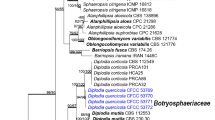Abstract
The taxonomic position of the causal agent of fruit rot of olives was determined from fresh collections of the fungus from central Greece. In culture it formed two types of conidia, namely fusiform, hyaline, aseptate conidia typical of the genus Fusicoccum, and dark-walled, ovoid, ellipsoid or fusiform, 1–2 septate conidia that are not typically observed in Fusicoccum. A phylogenetic analysis based on ITS and EF1-α sequences placed the fungus within the same clade as Fusicoccum aesculi, which is the anamorph of Botryosphaeria dothidea, and the type of the genus Fusicoccum.
Similar content being viewed by others
References
A Graniti (1993) ArticleTitleOlive scab: a review Bulletin OEPP/EPPO Bulletin 23 377–384
RM Jimènez-Diaz EC Tjamos M Cirulli (1998) Verticillium wilt of major tree hosts: olive JA Hiemstar DC Harris (Eds) A Compendium of Verticillium Wilt in Tree Species Ponsen and Looijen Wageningen, the Netherlands 13–16
CC Thanassoulopoulos DA Birris EC Tjamos (1979) ArticleTitleSurvey of verticillium wilt of olive trees in Greece Plant Dis Rep 63 936–940
A Maublanc (1904) ArticleTitleSur une maladie des olives due au Macrophoma dalmatica (Thüm.) Berl., Vogl Bull Soci Bot Fr 20 229–232
Petri L (1915). Le malattie del olivo. Ist Microgr Ital, Firenze, 104–105
JA Sarejanni AJ Papa (1952) ArticleTitleLa pathologie des mycoses á Macrophoma des olives Ann Inst Phytopathol Benaki 6 37–50
DG Zachos K Tzavella-Klonari (1979) ArticleTitleRecherches sur l’identitè et la position systématique du champignon qui provoque la maladie des olives attribuèe au champignon Macrophoma ou Sphaeropsis dalmatica Ann Inst Phytopathol Benaki Nouv Sèr 12 59–71
F Thümen (1883) ArticleTitleDie Pilze des Oelbaumes Boll Soc Adriatica Sci Nat Trieste 8 215–244
Saccardo PA (1884). Sylloge fungorum omnium hucusque cognitorum 3: 1–860
AN Berlese P Voglino (1886) ArticleTitleSopra un nuovo genere di Funghi sferopsidei Atti della Soc Veneto-Trentina Sci Nat 10 176–205
R Gigante (1934) ArticleTitleRicerche sulla morfologia, la biologia et la posizione sistematica del fungo che é stato descritto comme Macrophoma dalmatica Boll Ric Stazione Patol Veg, n.s. 14 125–172
Aa HA van der, Vanev S (2002). A revision of the species described in Phyllosticta. Utrecht, The Netherlands: Centraalbureau voor Schimmelcultures,
Anonymous (1968). Plant Pathologists Pocketbook. Kew, England: CMI,
A Alves A Correia J Luque AJL Phillips (2004) ArticleTitleBotryosphaeria corticola sp. nov. on Quercus species, with notes and description of Botryosphaeria stevensii and its anamorph Diplodia mutila Mycologia 96 598–613
White TJ, Bruns T, Lee S, Taylor J (1990). Amplification and direct sequencing of fungal genes for phylogenies. In: PCR protocols: A guide to methods and applications. San Diego, California: Academic Press, 315–322
I Carbone AM Kohn (1999) ArticleTitleA method for designing primer sets for speciation studies in filamentous ascomycetes Mycologia 91 553–556 Occurrence Handle1:CAS:528:DyaK1MXjvFeltro%3D
Swofford DL (2003). PAUP*. Phylogenetic analysis using parsimony (*and other methods) Version 4, Sunderland, Massachusetts, USA, Sinauer Associates
DM Hillis JJ Bull (1993) ArticleTitleAn empirical test of bootstrapping as a method for assessing confidence in phylogenetic analysis Syst Biol 42 182–192
Sutton BC (1980). The Coelomycetes. Kew, England: Commonwealth Mycological Institute
B Slippers PW Crous S Denman TA Coutinho BD Wingfield MJ Wingfield (2004) ArticleTitleCombined multiple gene genealogies and phenotypic characters differentiate several species previously identified as Botryosphaeria dothidea Mycologia 96 83–101 Occurrence Handle1:CAS:528:DC%2BD2cXislOgsro%3D
Aa HA van der (1973) ArticleTitleStudies in Phyllosticta I Stud Mycol 5 110
F Petrak H Sydow (1927) ArticleTitleDie Gattungen der Pyrenomyzeten, Sphaeropsideen und Melanconieen Beih Rep spec nov regni veg 42 1–551
F. Petrak (1961) ArticleTitleMacrophoma sapinea (Fr.) Petr. in den Föhrenwäldern des niederösterreichischen Waldviertels Sydowia 15 309–316
PW Crous ME Palm (1999) ArticleTitleReassessment of the Botryosphaeria anamorph genera Fusicoccum, Dothiorella and Botryodiplodia Sydowia 52 167–175
S Denman PW Crous JE Taylor J-C Kang I Pascoe MJ Wingfield (2000) ArticleTitleAn overview of the taxonomic history of Botryosphaeria, and a re-evaluation of its anamorphs based on morphology and ITS rDNA phylogeny Stud Mycol 45 129–140
Author information
Authors and Affiliations
Corresponding author
Rights and permissions
About this article
Cite this article
Phillips, A.J.L., Rumbos, I.C., Alves, A. et al. Morphology and phylogeny of Botryosphaeria dothidea causing fruit rot of olives. Mycopathologia 159, 433–439 (2005). https://doi.org/10.1007/s11046-005-0256-2
Received:
Accepted:
Issue Date:
DOI: https://doi.org/10.1007/s11046-005-0256-2




